Zixia Jia
Understanding and Leveraging the Expert Specialization of Context Faithfulness in Mixture-of-Experts LLMs
Aug 27, 2025

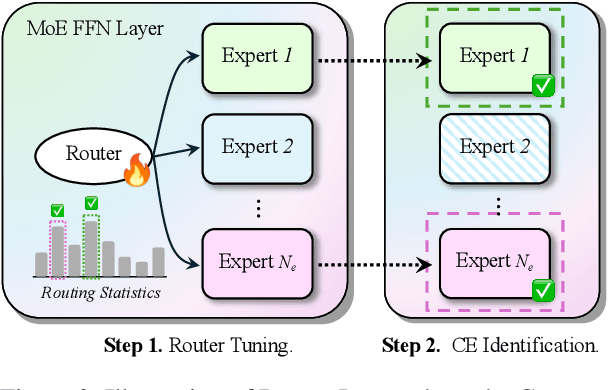
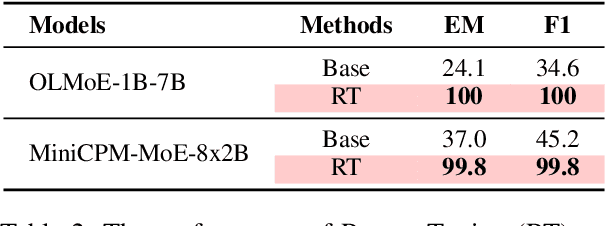
Abstract:Context faithfulness is essential for reliable reasoning in context-dependent scenarios. However, large language models often struggle to ground their outputs in the provided context, resulting in irrelevant responses. Inspired by the emergent expert specialization observed in mixture-of-experts architectures, this work investigates whether certain experts exhibit specialization in context utilization, offering a potential pathway toward targeted optimization for improved context faithfulness. To explore this, we propose Router Lens, a method that accurately identifies context-faithful experts. Our analysis reveals that these experts progressively amplify attention to relevant contextual information, thereby enhancing context grounding. Building on this insight, we introduce Context-faithful Expert Fine-Tuning (CEFT), a lightweight optimization approach that selectively fine-tunes context-faithful experts. Experiments across a wide range of benchmarks and models demonstrate that CEFT matches or surpasses the performance of full fine-tuning while being significantly more efficient.
TongSearch-QR: Reinforced Query Reasoning for Retrieval
Jun 16, 2025



Abstract:Traditional information retrieval (IR) methods excel at textual and semantic matching but struggle in reasoning-intensive retrieval tasks that require multi-hop inference or complex semantic understanding between queries and documents. One promising solution is to explicitly rewrite or augment queries using large language models (LLMs) to elicit reasoning-relevant content prior to retrieval. However, the widespread use of large-scale language models like GPT-4 or LLaMA3-70B remains impractical due to their high inference cost and limited deployability in real-world systems. In this work, we introduce TongSearch QR (Previously Known as "TongSearch Reasoner"), a family of small-scale language models for query reasoning and rewriting in reasoning-intensive retrieval. With a novel semi-rule-based reward function, we employ reinforcement learning approaches enabling smaller language models, e,g, Qwen2.5-7B-Instruct and Qwen2.5-1.5B-Instruct, to achieve query reasoning performance rivaling large-scale language models without their prohibitive inference costs. Experiment results on BRIGHT benchmark show that with BM25 as retrievers, both TongSearch QR-7B and TongSearch QR-1.5B models significantly outperform existing baselines, including prompt-based query reasoners and some latest dense retrievers trained for reasoning-intensive retrieval tasks, offering superior adaptability for real-world deployment.
ReflectEvo: Improving Meta Introspection of Small LLMs by Learning Self-Reflection
May 22, 2025Abstract:We present a novel pipeline, ReflectEvo, to demonstrate that small language models (SLMs) can enhance meta introspection through reflection learning. This process iteratively generates self-reflection for self-training, fostering a continuous and self-evolving process. Leveraging this pipeline, we construct ReflectEvo-460k, a large-scale, comprehensive, self-generated reflection dataset with broadened instructions and diverse multi-domain tasks. Building upon this dataset, we demonstrate the effectiveness of reflection learning to improve SLMs' reasoning abilities using SFT and DPO with remarkable performance, substantially boosting Llama-3 from 52.4% to 71.2% and Mistral from 44.4% to 71.1%. It validates that ReflectEvo can rival or even surpass the reasoning capability of the three prominent open-sourced models on BIG-bench without distillation from superior models or fine-grained human annotation. We further conduct a deeper analysis of the high quality of self-generated reflections and their impact on error localization and correction. Our work highlights the potential of continuously enhancing the reasoning performance of SLMs through iterative reflection learning in the long run.
Seek in the Dark: Reasoning via Test-Time Instance-Level Policy Gradient in Latent Space
May 19, 2025Abstract:Reasoning ability, a core component of human intelligence, continues to pose a significant challenge for Large Language Models (LLMs) in the pursuit of AGI. Although model performance has improved under the training scaling law, significant challenges remain, particularly with respect to training algorithms, such as catastrophic forgetting, and the limited availability of novel training data. As an alternative, test-time scaling enhances reasoning performance by increasing test-time computation without parameter updating. Unlike prior methods in this paradigm focused on token space, we propose leveraging latent space for more effective reasoning and better adherence to the test-time scaling law. We introduce LatentSeek, a novel framework that enhances LLM reasoning through Test-Time Instance-level Adaptation (TTIA) within the model's latent space. Specifically, LatentSeek leverages policy gradient to iteratively update latent representations, guided by self-generated reward signals. LatentSeek is evaluated on a range of reasoning benchmarks, including GSM8K, MATH-500, and AIME2024, across multiple LLM architectures. Results show that LatentSeek consistently outperforms strong baselines, such as Chain-of-Thought prompting and fine-tuning-based methods. Furthermore, our analysis demonstrates that LatentSeek is highly efficient, typically converging within a few iterations for problems of average complexity, while also benefiting from additional iterations, thereby highlighting the potential of test-time scaling in the latent space. These findings position LatentSeek as a lightweight, scalable, and effective solution for enhancing the reasoning capabilities of LLMs.
From Hours to Minutes: Lossless Acceleration of Ultra Long Sequence Generation up to 100K Tokens
Feb 26, 2025Abstract:Generating ultra-long sequences with large language models (LLMs) has become increasingly crucial but remains a highly time-intensive task, particularly for sequences up to 100K tokens. While traditional speculative decoding methods exist, simply extending their generation limits fails to accelerate the process and can be detrimental. Through an in-depth analysis, we identify three major challenges hindering efficient generation: frequent model reloading, dynamic key-value (KV) management and repetitive generation. To address these issues, we introduce TOKENSWIFT, a novel framework designed to substantially accelerate the generation process of ultra-long sequences while maintaining the target model's inherent quality. Experimental results demonstrate that TOKENSWIFT achieves over 3 times speedup across models of varying scales (1.5B, 7B, 8B, 14B) and architectures (MHA, GQA). This acceleration translates to hours of time savings for ultra-long sequence generation, establishing TOKENSWIFT as a scalable and effective solution at unprecedented lengths. Code can be found at https://github.com/bigai-nlco/TokenSwift.
Combining Supervised Learning and Reinforcement Learning for Multi-Label Classification Tasks with Partial Labels
Jun 24, 2024


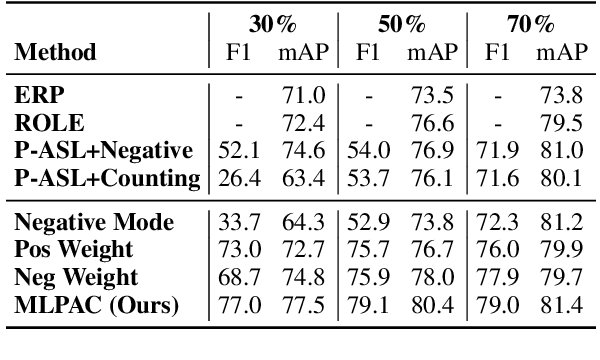
Abstract:Traditional supervised learning heavily relies on human-annotated datasets, especially in data-hungry neural approaches. However, various tasks, especially multi-label tasks like document-level relation extraction, pose challenges in fully manual annotation due to the specific domain knowledge and large class sets. Therefore, we address the multi-label positive-unlabelled learning (MLPUL) problem, where only a subset of positive classes is annotated. We propose Mixture Learner for Partially Annotated Classification (MLPAC), an RL-based framework combining the exploration ability of reinforcement learning and the exploitation ability of supervised learning. Experimental results across various tasks, including document-level relation extraction, multi-label image classification, and binary PU learning, demonstrate the generalization and effectiveness of our framework.
Sparser is Faster and Less is More: Efficient Sparse Attention for Long-Range Transformers
Jun 24, 2024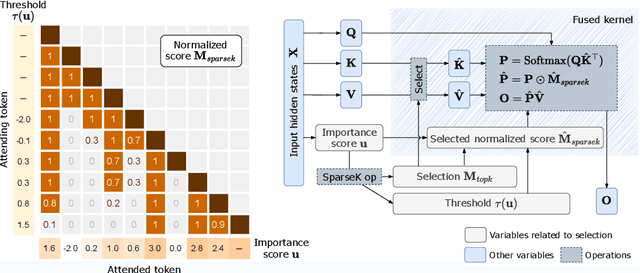
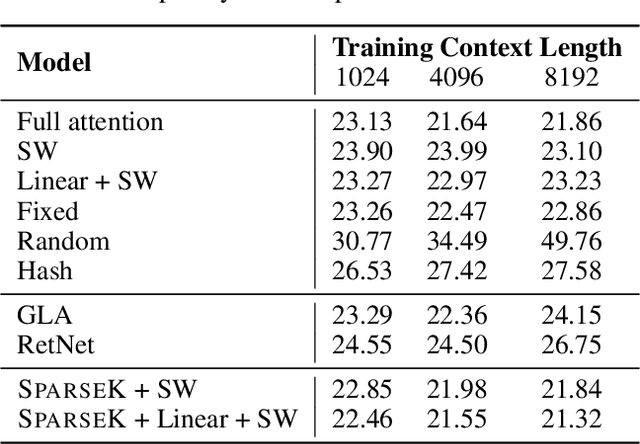


Abstract:Accommodating long sequences efficiently in autoregressive Transformers, especially within an extended context window, poses significant challenges due to the quadratic computational complexity and substantial KV memory requirements inherent in self-attention mechanisms. In this work, we introduce SPARSEK Attention, a novel sparse attention mechanism designed to overcome these computational and memory obstacles while maintaining performance. Our approach integrates a scoring network and a differentiable top-k mask operator, SPARSEK, to select a constant number of KV pairs for each query, thereby enabling gradient-based optimization. As a result, SPARSEK Attention offers linear time complexity and constant memory footprint during generation. Experimental results reveal that SPARSEK Attention outperforms previous sparse attention methods and provides significant speed improvements during both training and inference, particularly in language modeling and downstream tasks. Furthermore, our method can be seamlessly integrated into pre-trained Large Language Models (LLMs) with minimal fine-tuning, offering a practical solution for effectively managing long-range dependencies in diverse applications.
LangSuitE: Planning, Controlling and Interacting with Large Language Models in Embodied Text Environments
Jun 24, 2024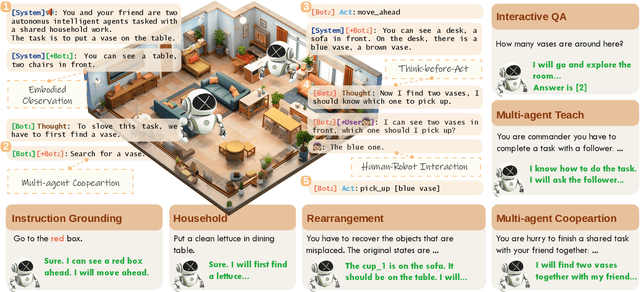

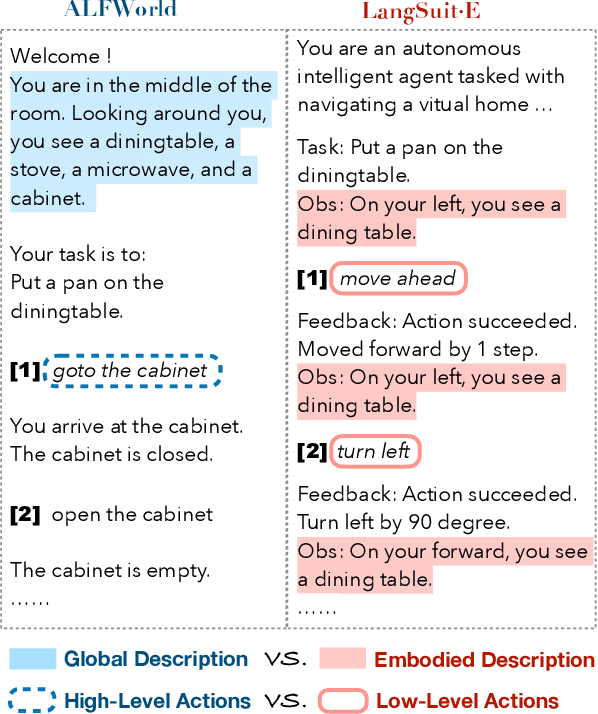
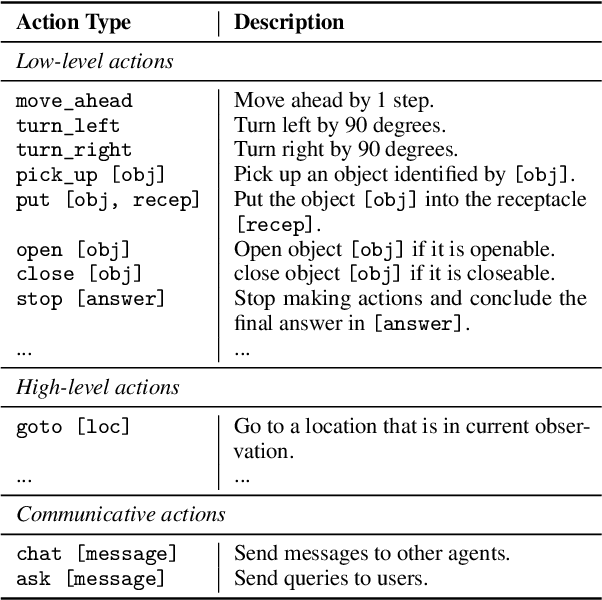
Abstract:Recent advances in Large Language Models (LLMs) have shown inspiring achievements in constructing autonomous agents that rely on language descriptions as inputs. However, it remains unclear how well LLMs can function as few-shot or zero-shot embodied agents in dynamic interactive environments. To address this gap, we introduce LangSuitE, a versatile and simulation-free testbed featuring 6 representative embodied tasks in textual embodied worlds. Compared with previous LLM-based testbeds, LangSuitE (i) offers adaptability to diverse environments without multiple simulation engines, (ii) evaluates agents' capacity to develop ``internalized world knowledge'' with embodied observations, and (iii) allows easy customization of communication and action strategies. To address the embodiment challenge, we devise a novel chain-of-thought (CoT) schema, EmMem, which summarizes embodied states w.r.t. history information. Comprehensive benchmark results illustrate challenges and insights of embodied planning. LangSuitE represents a significant step toward building embodied generalists in the context of language models.
Semi-automatic Data Enhancement for Document-Level Relation Extraction with Distant Supervision from Large Language Models
Nov 13, 2023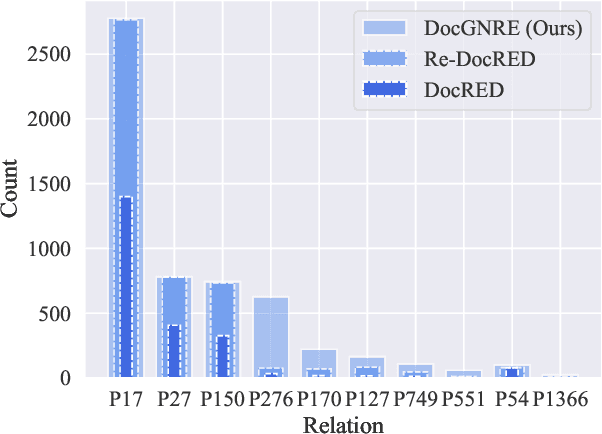
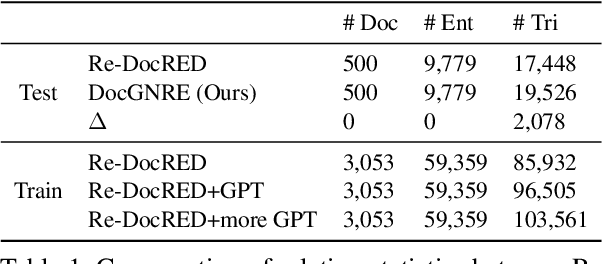
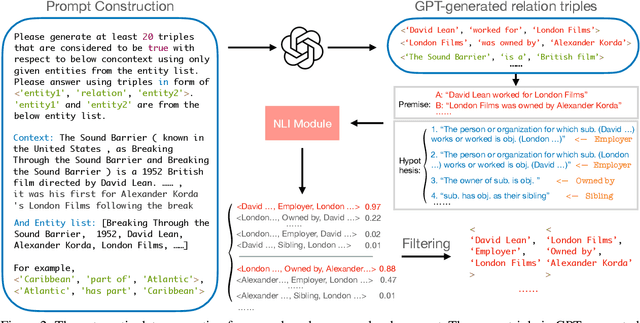

Abstract:Document-level Relation Extraction (DocRE), which aims to extract relations from a long context, is a critical challenge in achieving fine-grained structural comprehension and generating interpretable document representations. Inspired by recent advances in in-context learning capabilities emergent from large language models (LLMs), such as ChatGPT, we aim to design an automated annotation method for DocRE with minimum human effort. Unfortunately, vanilla in-context learning is infeasible for document-level relation extraction due to the plenty of predefined fine-grained relation types and the uncontrolled generations of LLMs. To tackle this issue, we propose a method integrating a large language model (LLM) and a natural language inference (NLI) module to generate relation triples, thereby augmenting document-level relation datasets. We demonstrate the effectiveness of our approach by introducing an enhanced dataset known as DocGNRE, which excels in re-annotating numerous long-tail relation types. We are confident that our method holds the potential for broader applications in domain-specific relation type definitions and offers tangible benefits in advancing generalized language semantic comprehension.
DAMO-NLP at SemEval-2023 Task 2: A Unified Retrieval-augmented System for Multilingual Named Entity Recognition
May 09, 2023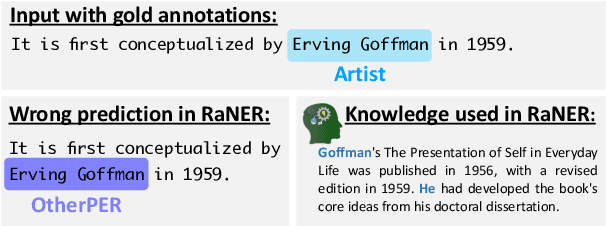
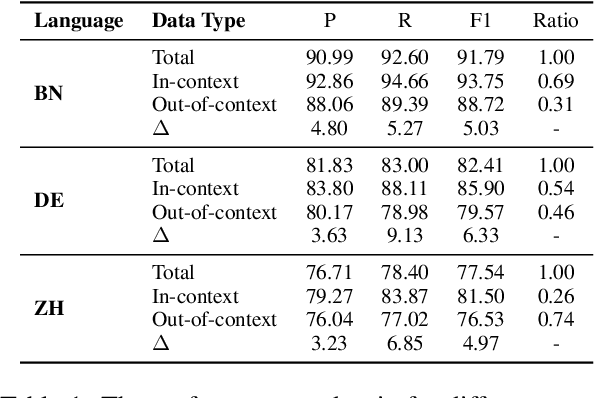
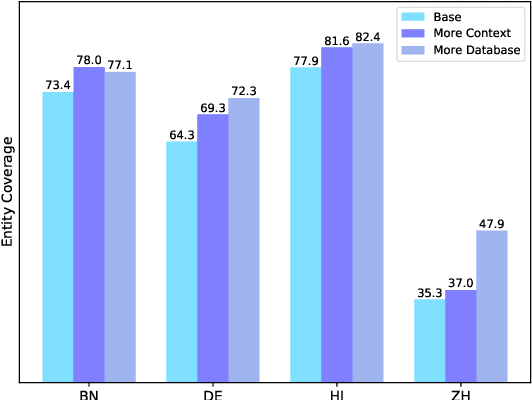
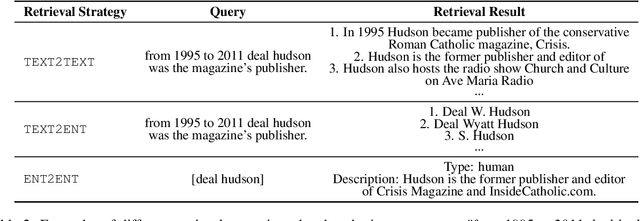
Abstract:The MultiCoNER \RNum{2} shared task aims to tackle multilingual named entity recognition (NER) in fine-grained and noisy scenarios, and it inherits the semantic ambiguity and low-context setting of the MultiCoNER \RNum{1} task. To cope with these problems, the previous top systems in the MultiCoNER \RNum{1} either incorporate the knowledge bases or gazetteers. However, they still suffer from insufficient knowledge, limited context length, single retrieval strategy. In this paper, our team \textbf{DAMO-NLP} proposes a unified retrieval-augmented system (U-RaNER) for fine-grained multilingual NER. We perform error analysis on the previous top systems and reveal that their performance bottleneck lies in insufficient knowledge. Also, we discover that the limited context length causes the retrieval knowledge to be invisible to the model. To enhance the retrieval context, we incorporate the entity-centric Wikidata knowledge base, while utilizing the infusion approach to broaden the contextual scope of the model. Also, we explore various search strategies and refine the quality of retrieval knowledge. Our system\footnote{We will release the dataset, code, and scripts of our system at {\small \url{https://github.com/modelscope/AdaSeq/tree/master/examples/U-RaNER}}.} wins 9 out of 13 tracks in the MultiCoNER \RNum{2} shared task. Additionally, we compared our system with ChatGPT, one of the large language models which have unlocked strong capabilities on many tasks. The results show that there is still much room for improvement for ChatGPT on the extraction task.
 Add to Chrome
Add to Chrome Add to Firefox
Add to Firefox Add to Edge
Add to Edge